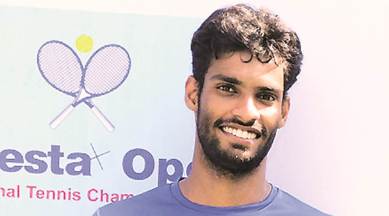Fenesta National Tennis: Antithesis of a modern tennis pro, Siddharth Vishwakarma earns his spurs
Siddharth Vishwakarma took up the game at six after a doctor advised his parents to enrol their child in a sport.

Barely minutes after being crowned the national champion, Siddharth Vishwakarma is lying prostate in the medical room at the DLTA complex. He has missed the presentation ceremony, and is spending the eve of his 24th birthday being worked upon by a concerned professional. With his face buried in a towel, Vishwakarma lets out a few muffled groans, gestures the tournament physio to stop and sits up against a wall. “This is due to the lack of cooldown and lack of stretching. I’ve been watching you for a week. When you just turn up for the match, the muscles tighten up and you end up doing damage,” says the physio. “That’s why one gets these spasms and cramps.”
Vishwakarma nods as the physio goes on schooling about “lactic-acid formation”, “postular biomechanics” and “required fluid intake” before he smiles sheepishly, and says the second-worst thing a tennis player could say. “Main fitness pe zyaada dhyaan nahi deta.” For Vishwakarma, the past year has been all about putting in some game time. He won another national tournament in February, before a string of defeats in qualifiers. The last time he made the main draw was at the Jakarta Futures in July, where he retired due to cramps in the second round. It was then that his ranking fell to 1896th in the world. On Saturday, Vishwakarma (1221) defeated 368-ranked Arjun Kadhe 6-2, 6-7(2), 6-3 to win the national championship. After making up for the runner-up finish two years ago, and earning a Rs3 lakh payday, he said the worst thing a tennis player could say: “Mera tennis me mann nahi laga kabhi.”
monthly limit of free stories.
with an Express account.
Vishwakarma took up the game at six after a doctor advised his parents to enrol their child in a sport. “I used to fall ill regularly as a child. So they thought physical activity would help. My father was busy working in factories so he asked my uncle to buy me a racquet.” What followed was a start-stop tennis career, during which he competed in under-18 tournaments at an age of 13, and left the sport to run a travel agency. “I always liked business more than tennis,” says Vishwakarma, who dropped out of college in the second year, and returned to tennis. “Padai me bhi mann nahi laga mera kabhi.” The unfiltered Vishwakarma, who is from Nadesar in Varanasi and represents Chhattisgarh, comes across as a breath of fresh air among players delivering PR-ready quotes in curated accents. “They talk American style because they are show-offs,” says Vishwakarma. “Whenever I meet Spanish or German players, they have always talked in their language, or in limited English. Their point is ‘go and learn our language.’ So if people ask me questions in English, I sometimes only talk in Hindi to mess with them. Aata mujhe sabkuch hai.”
In many ways, his opponent on Saturday was an antithesis of Vishwakarma. Pune lad Kadhe inherited the sport from his father Jayant, a former national-level player, and went to Oklahoma State University to take the US collegiate route. He returned last year as the next big Indian hope, if you listen to federation heads and top coaches. Since his return, he has won two singles and seven doubles Futures titles. He was picked for Davis Cup reserve duties as early as 2013 and as recently as last month’s tie in Serbia.
The contrast is evident on the court too. Kadhe, last year’s quarter-finalist, displayed solid, all-round game en route to the final. But he switched off when it mattered, and against a player who swats the yellow fuzz with utter disdain. With Vishwakarma, there are no half measures. The winners are stunning, the errors embarrassing. While his bazooka of a serve remained potent throughout the two hour, four minute-long match, it was Vishwakarma’s strong returns that made the difference. “I missed a few easy balls. But you have to give him the credit for his returns,” said Kadhe, who was often left rushing and out of position by the whipped short-arm jab returns. Coach Kamlesh Shukla credits the customised Korean bowling machine for his ward’s success.
“When you face 400-500 balls a day at the speed of 280kmph, your returns will get more efficient,” says Shukla. “As far as his service is concerned, he is the fastest in Asia at 226kmph.” Though difficult to measure without a speed gun, the 6’2 southpaw does send down bombs, at the usual sinister angles. His out-wide serve set up clean winners, and the diverse strokes from a semi-open stance further drew comparisons with a certain lefty Spaniard.
“I don’t see it,” shrugs Vishwakarma. “I don’t watch a lot of Rafael Nadal matches, or any tennis. Because it’s not like you can see a new thing and just learn it. To be honest, I can pitch a serve or a stroke at a point and send it out in four different angles. But if you ask me how I do that, I wouldn’t know. But I am only fifteen per cent behind Nadal as far as RPMs are concerned. I can reach 4800rpm (The Spaniard reaches 4,000). We checked with the racquet that records all data.” The maths doesn’t check out, but it doesn’t need to, as long as Vishwakarma stays entertained and keeps putting the monstrous spin on the ball. This diamond in the rough could shine bright, provided he is handled with care.